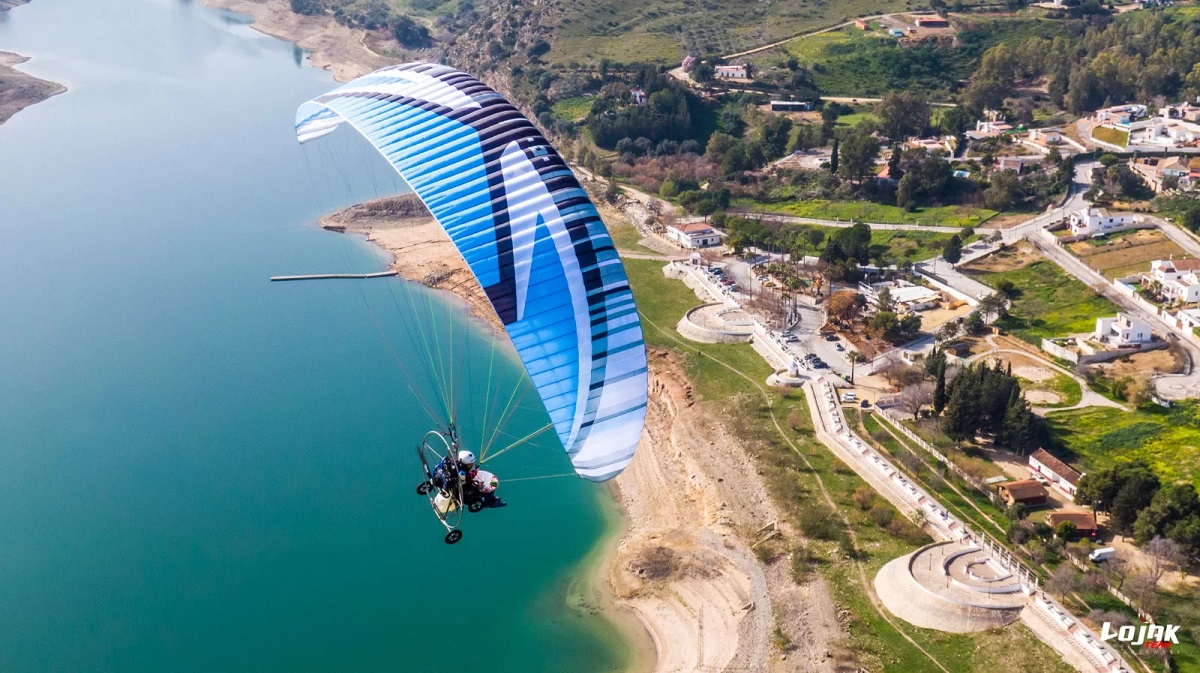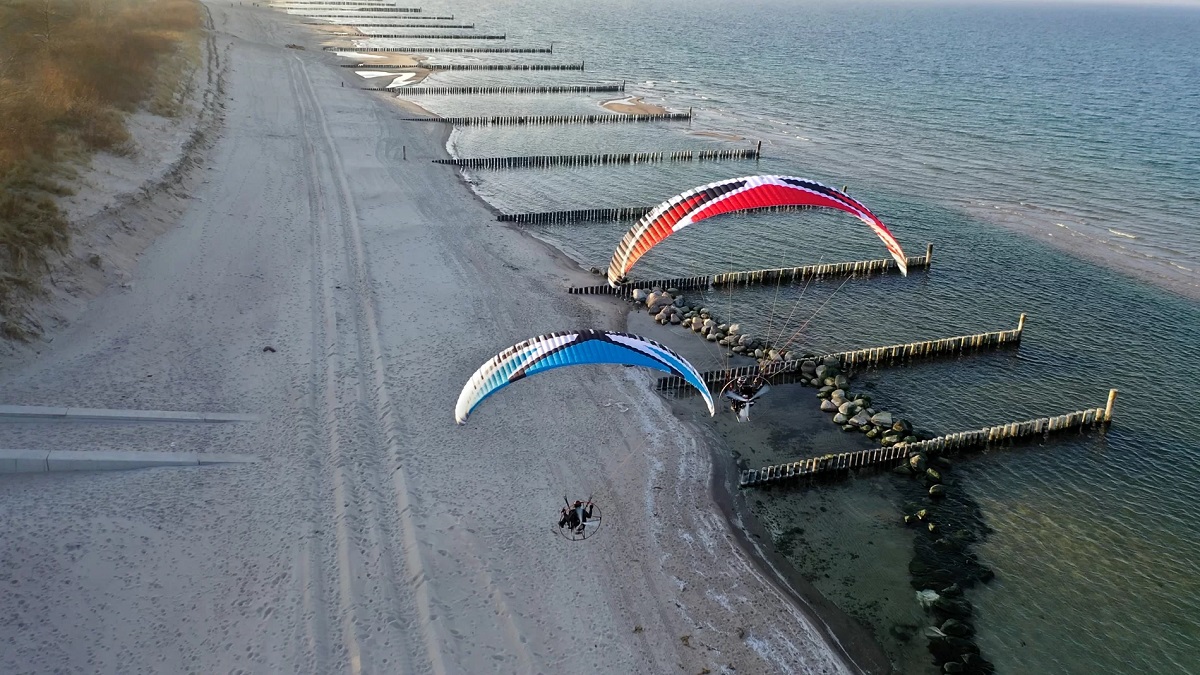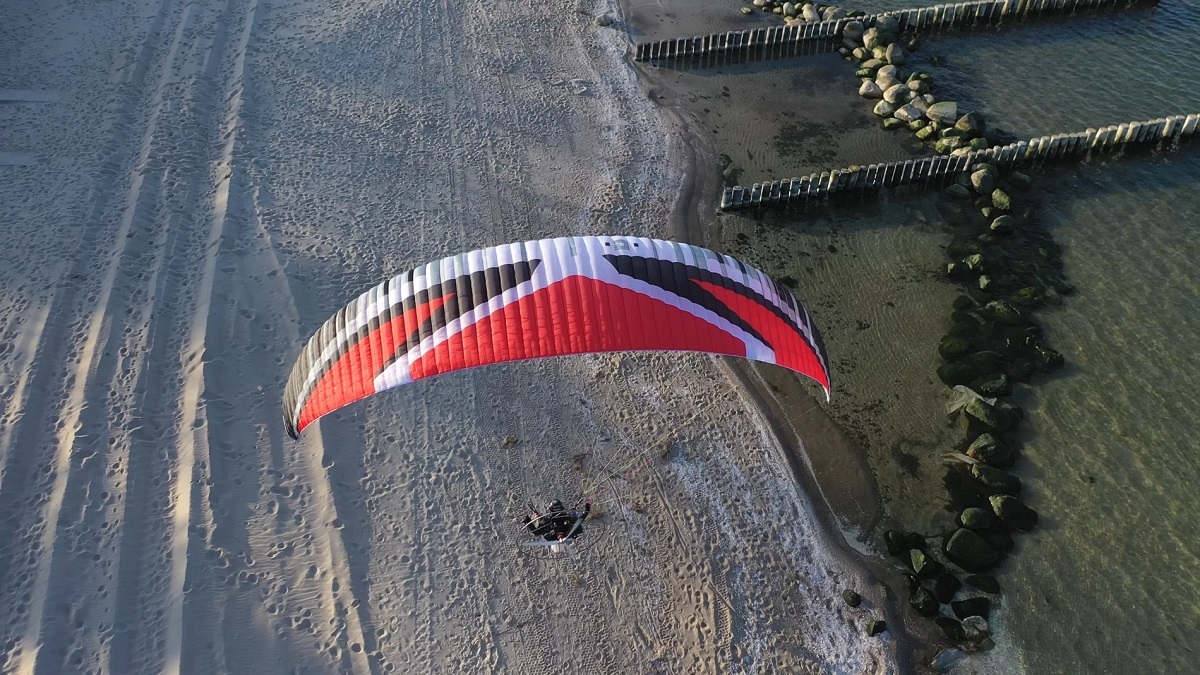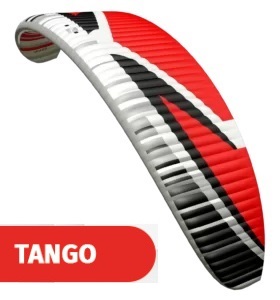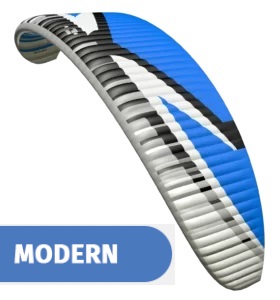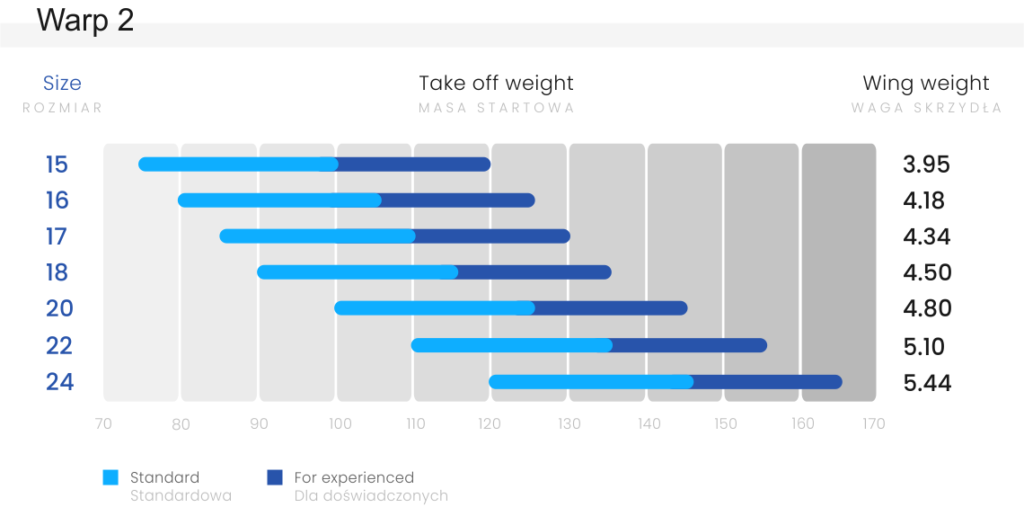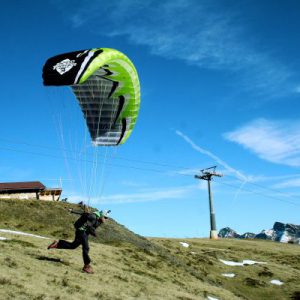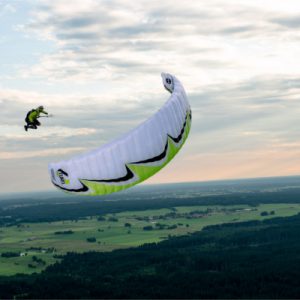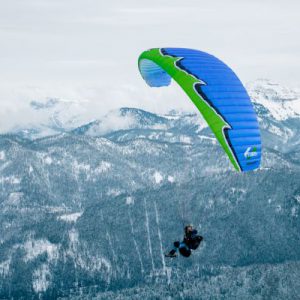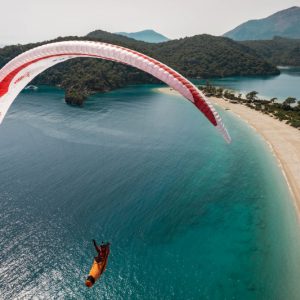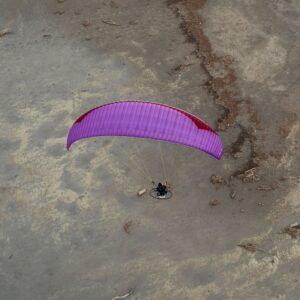Description
Warp 2 is designed especially for experienced pilots.
An ideal tool for classic competition and cross-country PPG flying: solid, agile, fast and efficient, offering a real pleasure of flying.
Warp 2 is definitely one of the fastest PPG paragliders in the world at the moment.
Cover longer distances, flying faster and more efficiently!
Warp 2 as compared to its previous version:
- inflates much easier and faster
- is more economical
- achieves higher cruising speeds
- even better flares at landing
Design
The significant improvement in the basic parameters of the Warp was possible due to:
slightly altered profile and decreased modifying its geometry when changing the angle of attack
incorporating the LE3D system, used in new generations of our wings
clean three-row rigging with 17% less lines used, resulting in less drag.
The entire structure of internal reinforcements, including the advanced diagonal support system 3Y and 3Y double (passing through two cells and ribs at once) plays a large role in the stability of the wing. It is further complemented by carefully tuned controls, an integrated PA (Power Attack) system and, of course, the highest quality materials used for production.
PROPERTIES
During take-off, the wing requires less attention from the pilot than in the previous version.
The wing eagerly rises above the pilot’s head during the run-up and efficiently takes him into the air even at maximum take-off weight, and even at considerable altitudes above sea level (some of tests were carried out at an altitude of 1100 m asml).
Pleasant, precise steering, especially in the upper range of the take-off weight. The progression of the required braking force helps to avoid too large angle of attack. In longer flights, steering comfort is ensured by the TST system, indeed necessary at maximum flight speeds. Its use does not affect the reflex properties of the airfoil. The maneuverability of the new Warp is impeccable, just like the previous version.
The reflex profile is a guarantee of safety in the entire speed range, even at low angles of attack, while ensuring a high maximum speed, much higher than in the Warp 1. Higher speed and lower fuel consumption allow for increased flight range.
The recommendations for getting used to the Warp 1 during the first flights at maximum speeds can be helpful: see PDF
Design solutions, technologies and other functionalities are listed below in the Technologies section.
TECHNOLOGIES, CONCEPTS
LE2R – Leading Edge Double Reinforcements
Leading Edge Double Reinforcements are additional reinforcements between les cellules, which stiffen the leading edge and keep the profile ‘clean’ during the flight at full speed.
SN – Shark-nose
Airtakes designed and executed in Shark-nose technology meaning specific, concave shape of the reinforced profile area at its leading edge (the name comes form the very shape, reminding shark’s nose).
DRA – Dudek Reflex Airfoil
DRA – Dudek Reflex Airfoil -applied in PPG wings fully autostabilised arofoil, based on long years of research and experience. In our variant we managed to get rid of typical flaws associated with these aerofoils.
CSG – Canopy Shape Guard
CSG – Canopy Shape Guard – is our unique system controlling canopy cohérence. It is because of this system that our wings are equally tensioned, smooth, stable and… simply remarkable.
LR – Laser Technology
Capabilities of the laser cutter permettre for serial cutting of complicated shape narrow elements in large numbers, their optimal placing in relation to structure of the textile and highest possible precision of cut.
FET – Flexi Edge Technologie
The leading edge is closed to the airflow, and its precise shape is kept with laminated cloth reinforcements, incorporating synthetic rods. The rods make the leading edge stiffer and smoother, bringing improvements in many areas – from easier inflation, through stiffening le baldaquin in flight to improved general airflow.
MR – Mini-Ribs
Mini ribs speak for themselves – they are additionally introduced in the trailing edge between main ribs. Their tâche is to diminution ballooning (expanding and déformation of the cells) in this vital area af the aerofoil.
Keeping the rear part in shape reduces the drag induced behind trailing edge, thus improving general airflow and increasing airspeed.
ACS – Auto Cleaning Slots
Dedicated slots automatically removing dirt from the wing tips.
USED SOLUTIONS
TCT – Triple Comfort Toggle
An easy conversion from hard through medium to soft brake handles. Equippped with a swivel adn Easy Keeper.
Available standard (bigger) and short (smaller) versions.
EK – Easy Keeper
Indigenous way to hold the brake handles at the risers that keeps them firmly in place, while both attaching and releasing goes smoothly and easily. Used in most of our handles (TCT, ACT, SCT).
TR – Trimmers
A trimming system for additional angle of attack regulation. Used mainly in PPG wings.
This system features replaceable trim straps. After prolonged or intensive operation they need to be replaced, as they get damaged by buckle edges.
SS – Speed System
A system of lines and pulleys sewn to the appropriate straps, connected to the bar hanging under the harness. It enables smooth adjustment of the angle of attack during the flight.
ELR – Easy Launch Riser
Split ‘A’ riser makes for easier launch and ‘big ears’.
TEA – Torque Effect Adjuster
The task of this feature is to counteract the effect of engine torque, that tends to make the paraglider turn in the direction opposite to the propeller’s rotation.
PA- Power Attack System
The PA (also known as Paap Kolar system) merges speed system with trimmer operation. It is devised only for competitors, understanding its effects and all difficulties involved.
The general idea is simple: pressing the speedbar simultaneously releases the trimmers (and vice versa, releasing speedbar closes the trimmers).
TST – Tip Steering Toggles
Our original idea, featuring additional miniature handles that steer the stabilizers. It is a great improvement on long flights, when opened trimmers and full speedbar make steering much harder.
2D – Steering System
2D system is generally similar to the classic one – pilot has but two main steering handles to steer. However, it’s operation is significantly different. Due to division of main steering lines (there are two for each side now, with one of them going outside of the pulley), an experienced pilot can modify steering progression according to his own preferences.
| WARP 2 | 15 |
16 | 17 |
18 | 20 | 22 | 24 |
| Approval – ULM Identification | pending | pending | pending | pending | pending | pending | pending |
| Number of cells | 62 | ||||||
| Wing area flat [m2] | 15.00 | 16.00 | 17.00 | 18,00 | 20,00 | 22,00 | 24,00 |
| Wing area projected [m2] | 12.76 | 13.61 | 14.46 | 15.31 | 17.01 | 18.71 | 20.41 |
| Wingspan flat [m] | 9.43 | 9.74 | 10.04 | 10.33 | 10.89 | 11.42 | 11.93 |
| Wingspan projected [m] | 7.58 | 7.83 | 8.07 | 8.30 | 8.75 | 9.18 | 9.59 |
| Aspect ratio flat | 6.00 | ||||||
| Aspect ratio projected | 4.50 | ||||||
| Speed* [km/h] | min = 31 ; trim = 48-65 ; max = 80 (+/- 3 km/h)* | ||||||
| Lines + risers length[m] | 5.50 | 5.68 | 5.86 | 6.03 | 6.35 | 6.66 | 6.96 |
| Total lines length [m] | 204.3 | 211.22 | 212.87 | 219.38 | 231.88 | 243.77 | 255.14 |
| Total ake-off weight** [kg] | 75-100** | 80-105** | 85-110** | 90-115** | 100-125** | 110-135** | 120-145** |
| Max take-off weight – for experienced*** [kg] | 120*** | 125*** | 130*** | 135*** | 145*** | 155*** | 165*** |
| Canopy weight [kg] | 3.95 | 4.18 | 4.34 | 4.50 | 4.80 | 5.10 | 5.44 |
| Distance betwen risers [cm] | 45 | 45 | 45 | 45 | 45 | 45 | 45 |
| Lines | A-8000U: 050; 070; 090; 130; 190 / Technora: 190; 280 / Dyneema: 350 | ||||||
| Cloth | Porcher Sport 38 g/m2, Dominico tex 34 g/m2, Porcher Sport Hard 40 g/m2, SR Scrim, SR Laminate 180 g/m2 | ||||||
* Speeds are given as estimated for the middle wing size and the middle of its weight range. These speeds can vary within +/- 3 km / h depending on the size, take-off weight and additional factors such as air pressure and temperature.
** The basic rule is to choose the size of the wing so that the take-off weight is in the middle of the weight range. Less weight on the wing (lower range take-off weight) can be considered for foot take-off, when flying in calmer conditions, or when we want to improve economy. More experienced pilots who want to fly dynamically, have higher speed and fly in more demanding wind conditions can consider greater wing loading (take-off weight in the upper range). This is a common option among trike users.
*** Note – the canopy significantly changes its behavior with increasing wing loading. The greater the loads, the greater skill and concentration of the pilot are required.


